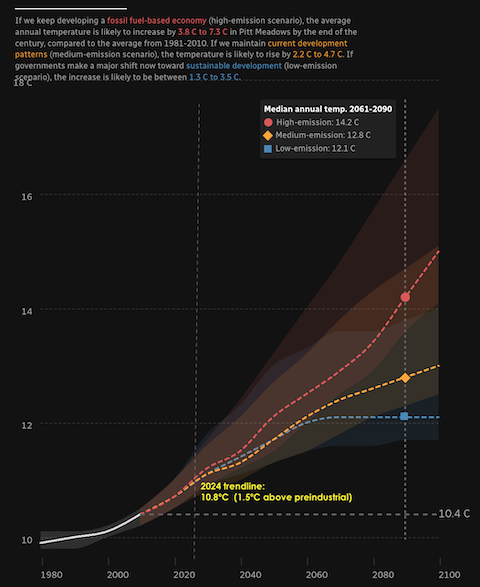
Cartoon by Chaz Hutton at Instachaaz
Yes, this is normal. No, wait, I mean, this is normal. All perfectly understandable. Yes, that group is pure evil. And that group over there is obviously insane. We need to work on that, get back control over things. But otherwise, it all makes sense. Our recent behaviour was a bit deranged, and perhaps inappropriate in retrospect, but it made perfect sense at the time. We’re making progress all the time, with a few setbacks. Inevitably it will work out fine. The gods, the leaders, the smart ones, the rich ones, the powerful ones, they’re on our side. History is on our side. We just have to work through some rough patches, overcome some obstacles, banish some detractors. In the long run, we can’t lose. Stop being such a pessimist, a defeatist. We have to win. It’s manifest. It’s written in the stars.
COLLAPSE WATCH

The closest Environment Canada weather station to me is Pitt Meadows, BC, Canada. We are currently at 1.5ºC above preindustrial average temperature here; most of Canada is (already) 2-3ºC above preindustrial average. Thanks in part to El Niño, the average temperature here has been 11.5ºC over the past 12 months. As I write this, the hottest place in Canada is Hay River, in the Northwest Territories, at 61ºN latitude, where it’s 34ºC. Normal August high there is 19ºC. Chart from CBC Interactives.
Average earth temperature smashes records again: At 17.16ºC, the global average surface temperature on July 22 broke all previous records, eclipsing the previous record set just a year ago. (The planet as a whole is warmest in July because most of the land area, which heats faster than the ocean, is north of the equator. It’s also where 90% of the human population lives.)
How mutual aid will make a difference as collapse deepens: Firefighters and other government and public service agencies already coordinate their activities across borders, a well-organized system called “mutual aid”. But the term also refers to citizen self-organization programs, most famously the disaster planning and response programs of Central American nations that can’t afford government-sponsored programs, and the self-policing networks in cities where official police forces refuse to venture (or are bought off by organized crime). Political and economic collapse will require a massive mobilization of such citizen-run programs, so it’s never too early to study them to see how and where they do, and don’t, work.
Collapse is so ‘last year’: As more and more scientists — and people — are coming to accept the inevitability of near-term civilizational collapse, they are also (not unreasonably) coming to accept there is nothing that can be done about it. So evidence of collapse is increasingly not ‘news’ and not covered in the news anymore.
LIVING BETTER

from the memebrary
Calling corporate oligopolies to account for price-fixing: The American Prospect devotes an entire issue to the various schemes oligopolies use to circumvent the already-lax rules on price-fixing to gouge their customers.
The electrification of everything: Cory Doctorow explores the logistics, politics, economics, materials management, engineering, and thermodynamics that are driving our current energy systems, and concludes that a radical switch to almost entirely electricity-based energy would be “a gigantic task, but it’s a tractable one”. In theory it could be done. That almost makes it worse, knowing it won’t be, and not because of greed or evil, but simply because of inertia.
A mind-changing video on transphobia: The uproar and blizzard of misinformation surrounding Algerian boxer Imane Khelif’s biology and her gold-medal-winning Olympic performance have produced far more heat than light. But where much of the controversy over participation of trans people in sports, and our treatment of trans people in general, is arguably ‘complicated’, and a balancing act, this particular case is a no-brainer. Imane is not trans. She is and always has been a woman according to all commonly-accepted definitions of womanhood. While I appreciate and agree with many of the concerns that radical feminists have expressed about incursions into the rights of, and equal opportunities for, women, and the degradation of the word ‘woman’ itself, I’m sorry but — to Derrick and all of the others piling on Imane — in this particular case you are simply wrong. And you are putting Imane’s life in jeopardy. And those doubling down on their attacks on her are making me rethink other aspects of my position on the whole thorny ‘TERF’ war between feminists and trans rights advocates.
POLITICS AND ECONOMICS AS USUAL

cartoon by Farley Katz from the New Yorker
Imperialism, Militarism & Fascism: Short takes:
- Daniel Dennett captures and summarizes the disgraceful behaviour of the US Congress in inviting and applauding the fanatic, genocidal war criminal Netanyahu, declaring it to be an incident destined to be seen in the history books as perhaps the defining and most infamous demonstration of the Euro-American Empire’s decline into moral fascism. An appeasement of atrocity of truly Chamberlainian proportions. This, we will not forget.
- Lovely rant by Moira Donegan on the US Republicans’ slue to extremist social repression: “If you’re a woman in America, Republicans want you to be a mother whether you care to or not. They want you to risk your health to give them more babies… They don’t want you to be able to get a divorce if your marriage turns unhappy or even abusive. They don’t want your daughter to be able to get birth control if her father doesn’t approve of it… They want to inspect your kids’ genitals before they let them play on the high school softball team. They want to ban books, and decide what your kids can and can’t read.”
- To ensure ‘ceasefire’ negotiations could not progress, Israel assassinated the chief Hamas negotiator, in Iran, and a Hezbollah leader in Lebanon, and then, supported by Biden-Harris, warned both Arab states that any retaliation for Israel’s atrocities in foreign sovereign nations would be treated as an “escalation”.
- Harris doubles down on US government support for the escalating Israeli atrocities and genocide.
- Last year, “undocumented immigrants” paid nearly $100B in US taxes, but received no benefits in return for them. Thanks to Kavana Tree Bressen for the link.
Propaganda, Censorship, Misinformation and Disinformation: Short takes:
- The independent (Canada-based) World Anti-Doping Agency has reported that the fraudulent US Anti-Doping Agency not only enables American athletes to cheat by using performance-enhancing substances without detection or sanction, but also collaborates in the spying on, and smearing of, other countries’ athletes. The clear message: The Olympics are a giant pro-Empire propaganda exercise, and Americans can only win by cheating.
- Bezos uses his WaPo mouthpiece to bully Harris to shift right
- How do we know the opposition in the Venezuela election won? Well, the CIA-backed polling organization doing exit polls declared it so. They wouldn’t lie to us, surely?
Corpocracy & Unregulated Capitalism: Short takes:
- Musk tries to reframe himself, absurdly, as an anti-establishment revolutionary reformer
- How the meat and dairy industries pressure the establishment US parties to let them manipulate prices and create fake demand
- A year ago, Facebook-Instagram banned Canadian news from its pages (since it would have had to pay Canadian media companies to include that news). The result: Less information, lots more misinformation.
- Why “leveraged buyouts” are just value-destroying, legalized corporate fraud
Administrative Mismanagement & Incompetence: Short takes:
- California governor Newsom, touted as a future presidential contender, has given up trying to deal with the complex homelessness/substance addiction/street drug poisoning/mental illness predicament, and ordered municipalities to just clear all encampments, and thus sweep the problem under the rug, threatening to withhold tax transfers if they don’t comply.
- Similarly, in Canada, poll-leading (for some unfathomable reason) right-wing nutbar Conservative leader Poilievre announced his intention to abolish all safe supply programs for street drugs and force all drug users into mandatory cold-turkey “treatment” facilities.
- Despite eliminating 350 positions to “balance the budget”, the CBC last year paid $18.4M in bonuses, disproportionately to top executives. Interestingly, the first media outlet to prominently report this disgrace was — the CBC.
Pandemic Watch: Short takes:
- Eight reasons the recent proliferation of medical mask bans is beyond stupid
- I’ve added the epidemiologists’ blog YLE to my blogroll Essential Reading list. Thanks to Tom Atlee for the link. Latest from YLE: Round-up on the early summer 2024 CoVid-19 wave, and CoVid-19 level soars in wastewater, and update on other potentially pandemic disease outbreaks
- Ontario (Canada) shuts down its exemplary wastewater epidemiological detection system
FUN AND INSPIRATION

Cartoon by Paul Noth from the New Yorker
The trouble with heat pumps: … is that they only work optimally in some (mostly newer, well-insulated) homes, and only under some (non-extreme) weather conditions. They’re really popular with governments subsidizing them so they look like they’re doing something important about climate collapse, but their impact is, well, kinda lukewarm.
Five things I’ve learned about America: Interesting take from a NY photographer on what he’s learned (somewhat to his dismay) about the people of his native country. To summarize, they are: lack of curiosity (leading to xenophobia), cult of individuality, anti-intellectualism, quantity over quality, and enduring diversity. Part of a series. Thanks to Annette Isaacson and Paul Heft for the link.
The re-indigenization of Canada’s place names: There is method in the chaos and conflict of renaming the many Canadian places named after racists and colonial malefactors. First Nations writer Robert Jago explains the process, and proposes a new, non-colonial name for British Columbia.
The process of enshittification: Andrew Nikiforuk explains Cory Doctorow’s thesis on why everything, especially the stuff produced by corporate oligopolies, just keeps getting worse and worse. Citing Joseph Tainter, he describes how all complex systems collapse when they can no longer afford the exponentially increasing costs of maintaining that complexity. He concludes: “Thank you, Cory Doctorow. We now have the perfect descriptor for how it feels to live in the twilight of an inattentive civilization that has sacrificed sanity for complexity.”
Why AI is financially non-viable: Yves Smith explains why getting AI systems to the point they actually do something useful, and well, will cost more than all its supporters can afford to invest in it. Not to mention using a staggering amount of energy.
Nice to have friends in high places: How the largest fraud in Germany’s history was abetted by those charged to prevent and prosecute it. You’ll have to use reader mode to work around the paywall. Thanks to Kavana Tree Bressen for the link.
Time is an illusion: Sabine Hossenfelder explains why that’s so. And then Brian Greene explains, in more detail, how it’s so, and why we continue to behave as if it isn’t.
Seymour Loudermilk hates vegans: Yes, it’s a spoof. But I’d guess a lot of viewers (there are billboards all over the US) won’t get the joke.
THOUGHTS OF THE MONTH

Cartoon by Grant Snider, from the memebrary
From Cory Doctorow (yes, him again) on Project 2025:
So we should be alarmed by the right’s agenda. We should be alarmed at how much ground it has gained, and how the right has stolen elections and Supreme Court seats to enshrine antimajoritarianism as a seemingly permanent fact of life, giving extremist minorities the power to impose their will on the rest of us, dooming us to a roasting planet, forced births, racist immiseration, and the most expensive, worst-performing health industry in the world.
From Daniel Schmachtenberger, on Reconnecting with the World:
Let’s consider a little kid who’s at the phase when they say, “What is that?” “What is that?” “What is that?” Right? They’re trying to understand, they’re trying to learn what all the things are, the anatomy of the universe. And that phase usually happens right before the phase where they say, why?, why?, why?, why?, why? – because then they’re trying to learn the mechanics, the dynamics of the universe.
So the kid says,“What is that?” And they point to a thing we call a tree.
But I don’t say “That’s a tree”, or more specifically, “That’s a spruce tree” or whatever, because that’s going to teach the kid a bunch of things: It’s going to teach them to just accept the default worldview and not think for themselves. It’s going to have them confuse the ground reality with a symbol. It’s going to have them think in generalizations, to understand what are trees and what are not trees, to generalize all of them and stop perceiving uniqueness.
So the kid says, “What is that?” And I’m like, “Let’s go closer.” And we go closer… And I’m like, “Touch it.” And “Touch the leaves” and then “Touch the flowers” and “Touch the bark” and, you know, “Touch all these parts.” And I’m like, “What does it feel like?”
And then “Smell it” and then “Notice the other little animals in it”… and, you know, just have them engage in that way.
And then I’d say, “Do you think the tree stops there? What about this moss that’s growing on it? Is that part of it – or is that not part of it? What about the the soil? Is that part of it or not part of it?”
And then I’m like, “What do you think it is to that squirrel? What do you think it is to that little bug? What do you think it is to itself?” And “What do you feel when you’re with it?”
And eventually I’ll say something like, “In English, we call this a tree. In Spanish, they call it arbole. And in this language, they call it this…” and all the different kinds of things. “But this particular one – notice that if we go look at this one, they’re different. And in fact, this one, there’s not another one in the entire universe quite like it. And it’s not even the same as it was yesterday, and it’ll be different tomorrow.”
So they’re learning that the only way to know it is to be with it fully, more presently in this moment.
So imagine if kids grew up that way (rather than “That’s a tree. Memorize its Latin name. Understand the botany associated with it” … blah, blah, blah…) They’re using much more of their whole self to understand reality in a much more full, rich way that understands that that same thing is different from every different perspective and in so many different contexts. And so if someone is perceiving – if they are supported to perceive – the uniqueness of everything and the interconnectivity of everything – that nothing is fungible and nothing is separable – then they get that nothing can be standardized without actually causing harm and nothing can be optimized at the expense of others without causing harm. They get that special uniqueness and interconnectivity of everything and they get “I am because we are” – the principle of Ubuntu – for a “we” that extends to the stars.
And then the hungry ghost desire is not the main thing that emerges. What emerges from that connection are awe and fulfillment and fascination and gratitude. And it’s actually the lack of that connection that leads to the hungry ghost place that hungers for more and more hits and progress.
The desires that do emerge are in connection with everything else that I’m connected with. When a desire emerges, I wonder will it be good for the tree? Is it bad for the tree? What about the squirrels in the tree? I just spent time communing with them. I love them. I wouldn’t want – and it wouldn’t be good for me – if acting on this desire hurt those squirrels.
Now, the desires that arise for people who are clear on their inner connectivity with everything, those desires can be pursued in a way that doesn’t harm anything because their own identity is not separate from everything – because their perception is clear.
From Shuly Xóchitl Cawood, on The Last Biscuit (from NYT Tiny Stories; read how she wrote this):

Before the city pool in Johnson City, Tenn., got drained at summer’s end, dogs could take a swim for five bucks. Sporting his green life jacket, Barney leapt in as if he weren’t tired, deaf, toothless. We stayed until no one else was left. It’s a small thing in life, a dog, but small is relative. I packed biscuits for our last trip to the vet. I sat on the floor in the lobby, feeding Barney biscuits one by one, and for a moment it seemed possible that we might never run out.





So lovely. The Last Biscuit. Thank you!
And thank you for pointing us to the Khalif controversy. Until now, I had no idea what it was really about. So I looked a bit deeper, and you are right. This is not about trans at all. This person was raised as a girl, she followed the guidelines of her boxing club and associations, and deserves her medal. Her treatment has been appalling. Many people seem to have lost the capacity to wait with their opinions until more facts come in.
To the best of what I was able to dig up, this was a male baby (testes, testosterone, XY, penis, prostate, male biological body with all it entails) who was deemed to have — in the view of caregivers — a substandard penis due to a genetic abnormality and was therefore raised (understandably) as a girl. — On the other hand… is there also a possibility she is intersex?
It would be good if people stopped yelling insults across the chasm and actually talked about how to deal with such a situation in sports, in the future, particularly in sports where a male body conveys a massive advantage, like boxing, and can result in considerable injuries to the female body.
Having followed over the years the story of the Reimer twins where one of them was raised as a girl after his penis was amputated after a botched circumcision, I am also wondering about the wisdom of forcing a boy to grow up as a girl (it turned out disastrous for the Reimers). But at the same time I see some good reasons for this; what a terrible dilemma for the parents and doctors!
Thank you, Dave.
Although I stopped watching the Olympics and all corporate sports, I got interested in the Imane Khelif boxing story because I boxed when I was young and was a fan for decades. Within less than a minute, while stupid white people were screaming their faces off, I learned she was not a trans woman. Imane was born with ‘Swyer Syndrome’ (XY Gonadal Dysgenesis). Even JK Rowling did not take 30 seconds to look.
.
The cyber-mob are just a bunch of screeching tribal monkeys flinging digital poo at each other all day. Most of them do not want to know. That would ruin their virtue and tribal loyalty signalling.
More Women Than Expected Are Genetically Men
Sex chromosomes usually determine whether you are female or male. Women are XX. Men are XY. However, genetically, a few women are actually men. They grow up as women with a woman’s body, and most only discover well into puberty that they are different. Danish researchers map for the first time how many women are genetically men. The proportion was higher than expected.
Sex chromosomes usually determine whether you are female or male. Women are XX. Men are XY. However, genetically, a few women are actually men. They grow up as women with a woman’s body, and most only discover well into puberty that they are different. Danish researchers map for the first time how many women are genetically men. The proportion was higher than expected.
You cannot see it if you do not know what you are looking for. One in 15,000 males is born and grows up as a girl. And neither these girls nor their parents know it. These girls do not discover anything different until puberty.
“Girls born with XY chromosomes are genetically boys but for a variety of reasons – mutations in genes that determine sexual development – the male characteristics are never expressed. They live their lives as girls and then women, and a few can even give birth. Our research, which is the first nationwide survey in the world, shows that this group is up to 50% larger than previously assumed. How these girls discover the facts and talk openly about their situation also varies greatly,” explains Claus Højbjerg Gravholt, who led the study and is Clinical Professor in the Department of Clinical Medicine of Aarhus University.
https://novonordiskfonden.dk/en/news/more-women-than-expected-are-genetically-men/
Thanks DrS.